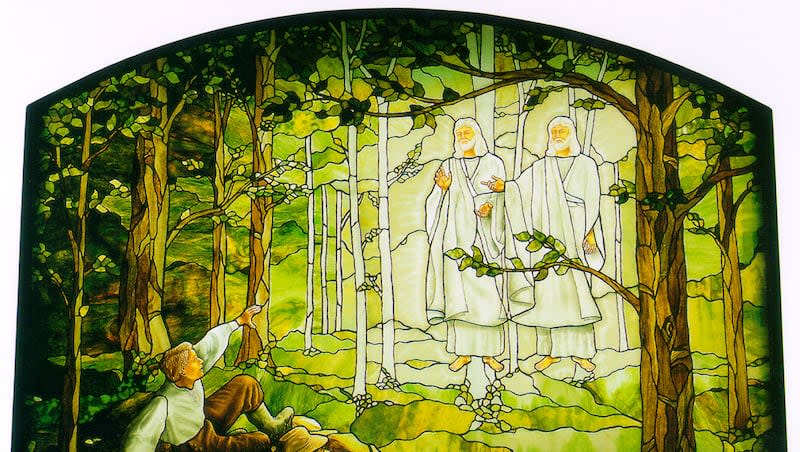An overlooked text supporting Joseph Smith’s First Vision consistency

- Oops!Something went wrong.Please try again later.
Editor’s note: This commentary is part of an ongoing Deseret News series exploring ideas at the intersection of faith and thought.
With spring now officially here, some Latter-day Saints have no doubt reflected on Joseph Smith’s First Vision, which took place in the spring of 1820. Smith’s First Vision is hailed by members of The Church of Jesus Christ of Latter-day Saints as the beginning of the Restoration of Christ’s restored gospel.
Like differences between the New Testament Gospel accounts, scholars have likewise had questions about the differences in the available accounts of the First Vision. The multiple accounts of the First Vision vary in detail, with Joseph Smith’s earliest written account (1832) lacking some elements found in his later accounts. Most notably, this account refers to Joseph seeing “the Lord” — Jesus Christ — without specifying that he also encountered God the Father.
This has led some critics to allege the inclusion of God the Father in Joseph Smith’s subsequent First Vision accounts was a later, manufactured addition to the vision as first documented in 1832.
However, new findings indicate that the presence of God the Father in the First Vision was already established in 1832-1833. In a recent issue of BYU Studies, we contribute to the growing body of work on the First Vision and present the evidence for the Father’s inclusion in the early accounts of the First Vision.
Although the 1832 account does lack some elements found in later accounts, a number of those same elements can be found throughout Joseph Smith’s translation of the Bible. Joseph Smith Translation of Psalm 14, for instance, includes a search for a correct view of the divine (“Seek ye among the children of men, to see if there are any that do understand God”), the condemnation of corrupt preachers (“workers of iniquity”) and anticipation of the restoration of the Church/Zion (“O Lord, when wilt thou establish Zion?”).
Sometime between July 1832 and July 1833, Joseph Smith completed this inspired Bible revision. It was during this period that he recorded both his 1832 account of the First Vision (July-September 1832) and two specific passages in the New Testament. In its KJV form, John 1:18 reads, “No man hath seen God at any time; the only begotten Son, which is in the bosom of the Father, he hath declared him.” Smith’s revision found in the JST manuscript adds a condition on which the Father can be seen: “And no man hath seen God at any time, except he hath born record of the son. For except it is through him no man can be saved.”
In Smith’s rendition, God the Father can be seen, with the proviso that he always bears record of the Son to those privileged to see him. This is as Smith would describe it in later First Vision accounts: “I saw two Personages, whose brightness and glory defy all description, standing above me in the air. One of them spake unto me, calling me by name and said, pointing to the other—This is My Beloved Son. Hear Him!” (JS-H 1:17).
In an exact echo of John 1:18, the KJV of 1 John 4:12 reads, “No man hath seen God at any time.” Smith again qualifies this with a proviso in his translation: “except them who believe.”
In both alterations — made several months before Smith’s earliest recorded account of the First Vision in 1832 — God the Father is made visible. And in each alteration, a condition is presented on which the Father can be seen — a condition met by Smith in his own First Vision account: Before he saw the Father, he exercised faith and became one of “them who believe,” meeting the condition specified in JST 1 John 4:12. He also heard the Father bear “record of the Son,” meeting the condition specified in JST John 1:18.
Given Smith’s changes to these passages — in each case qualifying the apparent absoluteness of the statement “No man hath seen God” — it is intriguing that he imports this very phrase into the beginning of his revised Psalm 14, “The fool hath said in his heart, There is no man that hath seen God. Because he showeth himself not unto us, therefore there is no God.”
Having revised the two New Testament passages to stipulate conditions on which human beings can see God the Father, the “fool” who denies God in Psalm 14:1 now becomes one who denies any possibility of theophany. This would include the preacher who treated Joseph’s own theophany with “great contempt, saying it was all of the devil, that there were no such things as visions or revelations in these days” (JS-H 1:21).
Smith’s revisions to the Bible discussed here provide evidence that these supposedly late-developed elements of the First Vision may actually predate even the “earliest” First Vision account.
Already by 1831-1832, Joseph Smith’s translation of John 1:18 and 1 John 4:12 intimates that he connected his First Vision with the idea of seeing God the Father and of God the Father bearing witness of the Son. In his 1833 translation of Psalm 14, Joseph’s translation likewise echoes the First Vision, reinforcing that God the Father was part of the vision and weaving in further elements that will not appear in his own formal accounts for several years. Thus, Joseph Smith’s translation of the Bible is yet one more element suggesting Joseph Smith was consistent in attesting to the nature of the First Vision events from the beginning of his prophetic career.
Don Bradley is an independent historian and the author of “The Lost 116 Pages: Reconstructing the Book of Mormon’s Missing Stories.” Walker Wright works for a public policy think tank in Washington, DC, and has published on economics, theology, and politics.

